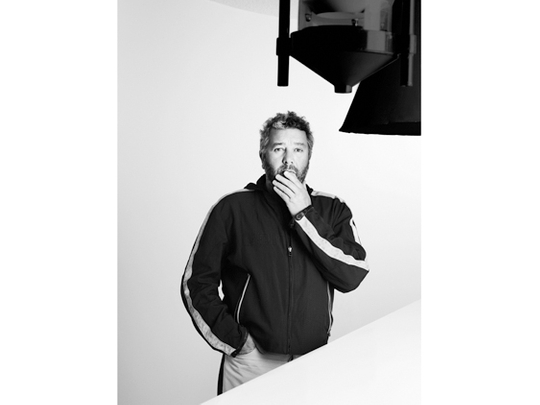
A dead silence pervades the room; it bounces off the raw red, exposed brick walls and reverberates from the too-high concrete ceilings of what was once a Berlin power plant, now gentrified to a hip events space. It’s just a momentary pause though while Philippe Starck collects his thoughts, then laughs. Warmth returns to the space again. Starck has just been asked if designing makes him happy. “Creating is not fun, it’s hard work,” he responds with rare seriousness. “It’s a drug addiction. You have to fight it and want it, every minute of every day.”
In his trademark black Dainese jacket, worn over a rumpled neon green hoodie and sweat pants, and accompanied by his flawlessly chic (and much younger) wife Jasmine, Starck looks more an ageing rockstar than a Renaissance man. Suffice to say, he is a bit of both. He has more than 11 homes around the world, including one on an oyster farm in southwest France, one in Formentera near Ibiza and in one Burano near Venice; plus houses on islands without electricity and in places only reachable by boat. Yet he also owns 30 cars and 30 motorcycles and confesses that he loves riding bikes at speeds of 250kph or faster.
Starck belongs to an elite pantheon of design – prodigiously talented and extremely prolific, commercially successful and able to do just as he pleases. There aren’t too many designers who design mostly in their bed on plastic-coated paper that has been specially created to withstand their constant jet-setting. Starck is in the middle of what he describes as his, “silly time of the year”; the time when he takes a break from designing to bounce around the world in his Pilatus PC-12 Swiss Army plane, to meet clients and interact with adoring media and appreciative audiences.
At the Berlin event to launch Axor Starck Organic, he throws open the floor to questions from the audience with an impish suggestion, “You can ask me any question you like. How did an old, fat, grumpy guy like me get a wife who is so beautiful? That could be one question.” The 63-year-old father of five (his curiously named children – Ara, Oa, K, Lago and Justice – got names he says that were randomly chosen from a computer programme), is never seen these days in public without his fourth wife, the elegant Jasmine Abdul Latif. Starck credits nature and his wife’s taut, beautiful form as the inspiration for the range of taps he has designed for Axor Starck Organic.
It’s easy to see that a good deal of Starck’s appeal as a designer and as a person is his humour; much of it self-deprecating. It shines through even in the products he designs: be it the Juicy Salif citrus squeezer for Alessi, which stands like a three-legged extra-terrestrial being, or the Louis Ghost chair designed for Kartell, a playful take on the iconic Louis XV armchair that went on to become a 21st-century best-seller. “Humour is very important to my work,” he says. “It shows how intelligent mankind really is.”
Starck’s irreverent brand of design will soon be seen in the Middle East, courtesy of the soon-to-be-opened Katsuya by S+ARCK restaurants, the first two of which will debut in Kuwait and Dubai in 2013. His father, André, an inventor (he invented the twisting lipstick tube) and aeronautic engineer, was a seminal influence on a young Starck. After being educated in Paris, he founded Starck Product, which he renamed Ubik after the Philip K Dick novel. Ubik forged collaborations with big-name design powerhouses: Driade, Alessi, Kartell, Vitra and others.
Starck was propelled into the public eye with his 1983 commission for French President François Mitterrand, to decorate the private residences at the Élysée Palace. Since then he has been an ambassador for French New Wave design. He has put his stamp on toothbrushes, motorbikes, mega-yachts, space-travel projects, baby bottles, furniture, boutique hotels, organic food and even wind turbines for the home to produce green energy. At the Berlin event, Starck speaks passionately of democratic design; of making high-quality, high-design objects affordable to many so more people can enjoy design.
Long before it became a buzzword, Starck was espousing the cause of dematerialised design – a reductive aesthetic that will ultimately result in more sustainable products. Somewhat obsessed with making design accessible to all, he created a line of sixty daily-use items for American chain Target in 2002. One of his latest works, the Wahh Quantum Sensations flavour dispenser, is another example of this. Priced at €20 (Dh96), when sprayed into the mouth it dispenses minute quantities of alcohol, loaded with the taste and memory of an intense sensation.
“We are losing young people to the horrors of binge drinking, a whole generation is dying,” Starck says. Wahh Quantum Sensations embodies Starck’s twin passions for dematerialisation and democratic design; achieving more with much less, while being accessible to all.











